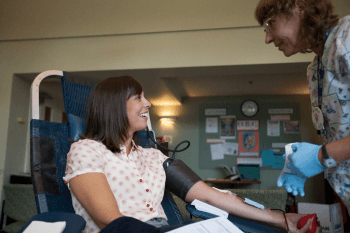Blood drives are a life-saving tradition at Washington University. Sponsored by the Gephardt Institute in partnership with American Red Cross and Mississippi Valley Regional Blood Center, drives take place four times a year at multiple locations across campus. Although they have become a routine part of the university’s culture, few people realize that a majority of the planning takes place behind the scenes thanks to the Gephardt Institute’s Blood Drive Leadership Team (BDLT). BDLT members work on a volunteer basis to raise campus awareness and education, market events, support donors and blood bank partners on drive days, and partner with campus groups to make blood drives an inclusive effort. Below, several BLDT members offer their perspectives on their roles and experience.
Sydney Curtis, ’19
Can you explain your role in university-wide blood drives?
As a member of the Blood Drive Leadership Team, I meet with other coordinators a couple of times a month and more frequently as blood drive dates approach. I am on a committee that works to improve the donor experience. We seek to reduce wait time and encourage retention.
Why would you encourage people to donate or get involved?
There is never enough blood in the banks for the amount of blood needed in the world. Especially with all the natural and human-caused disasters as of late, there is an incredible need. Being a part of the BDLT is a good way to get socially involved and help people in a place far away, without actually traveling that distance.
Thomas Van Horn, ’18
Can you explain your role in university-wide blood drives?
I am on the Donor Education and Outreach Committee. We table in the DUC and have recently started initiatives to get more high iron foods in service lines leading up to the drive. Most of our job is on the education and appreciation side.
Why would you encourage people to donate or get involved?
Giving blood is a really simple thing and just takes an hour. If you analyze the amount of time we spend on our phones or watching Netflix, we can all take an hour once every six weeks. It really makes a difference. I am pre-med and have shadowed surgeries where we’ve gone through 12 pints of blood. There’s a real need.
How can people get involved if they can’t donate?
You can join BDLT or even volunteer by doing simple things like giving people snacks at the canteen. Just spreading the word is a huge help. Our campus drives produce about 300 units a drive, regardless of whether you donate. You can help spread awareness to increase that count this November.
Alison Swearingen, ’18
Can you explain your role in the university-wide blood drives?
I primarily focus on working with other campus groups involved in advocacy for donating and saving lives. We promote the blood drives through these organizations and focus on outreach.
Why would you encourage people to donate or get involved?
Donating blood is a quick and easy way to save lives. It is a meaningful thing to do. Even if you can’t donate blood for whatever reason, you can easily get involved with our team or help with promotions.
What do you think is one thing that would surprise people about the Blood Drive Leadership Team?
I think it would surprise people just how involved we are. It is incredible to work with people who are passionate about the blood drives for such a wide variety of reasons. It’s also an educational experience.
Lauren Hucko, ’20
Can you explain your role in the university-wide blood drives?
I’m the leader of the advocacy committee. We create advocacy campaigns between drives regarding the FDA’s blood donor policies. We raise awareness and educate people on campus about the issue.
Why would you encourage people to donate or get involved?
I would encourage people to donate because it’s such a tangible method of service, and one you don’t need to do continuously. I’ve struggled with finding methods of meaningful service that benefit someone in a measurable way. Blood donation does that and helps up to 3-6 people and their families. It’s a great way to practice productive service.
How can people get involved if they can’t donate?
We are accepting applications for BDLT. We also have an ally donor program, so if someone cannot or chooses not to donate, they can identify a friend or colleague to do so. We also accept volunteers on the day of the drive.
_____
Our next University-Wide Blood Drive is on November 15, and we welcome all members of the WashU community to donate or help promote the event. Students may also apply to be a part of the Blood Drive Leadership Team by clicking here.
